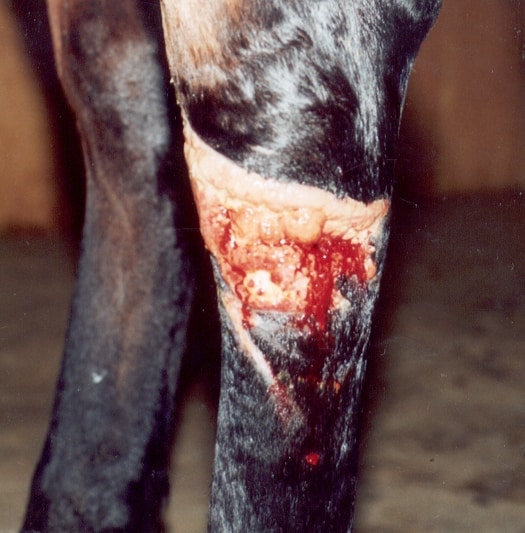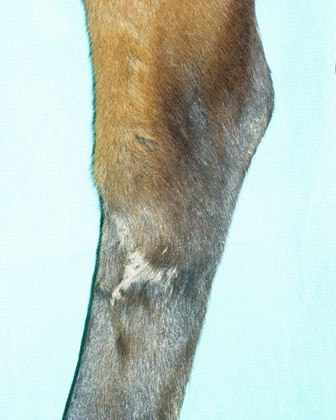Things You Should and Should Not Put on a Horse’s Wound

Horse owners and veterinarians have been treating equine wounds for centuries. After all, horses are unabashedly practiced at the art of sustaining wounds. Over the years we’ve tried many different wound ointments and salves, cleansers and dressings, but not all of them are backed by evidence of safety and/or efficacy.
So Dean Hendrickson, DVM, MS, Dipl. ACVS, professor of equine surgery at Colorado State University, in Fort Collins, went back to basics, describing effective and ineffective wound-cleaning agents to an audience of veterinarians at the 2015 Annual American Association of Equine Practitioners Convention, held Dec. 5-9, in Las Vegas.
Although our intentions are good, “most wound-cleaning agents and techniques will cause chemical or mechanical trauma to the wound bed,” he said. “Weigh the benefits of cleaning the wound against the trauma that agent will cause.”
In other words, ask yourself: Is that cleaning agent ultimately going to speed up or retard wound-healing?
Before applying anything, however, clip the hair around the wound to prevent it from contaminating the area. Then, use sterile gauze to very gently scrub the wound. “If gentle scrubbing doesn’t work, use a different technique,” said Hendrickson. “Don’t scrub harder.”
One approach is saline lavage to remove surface debris—“One of the best things we do,” he said. Again, don’t use much pressure; a gentle showerhead-type sprayer works well.
Hendrickson then delved into the common topical treatments we apply to wounds and which ones are safe to use.
Saline
Hendrickson referenced saline again and again throughout his presentation as one of the most simple, yet effective, wound-cleaning agents. Hypertonic saline, in particular, is very effective for debriding (removing surrounding dead, damaged, or infected tissue) while lavaging and for reducing bacteria in the wound. It does have the ability to damage normal cells, as well, he cautioned, so use it only in infected wounds.
Povidone Iodine (PI)
While povidone iodine has been used extensively in equine wound care, Hendrickson cited several studies showing that it causes tissue necrosis, impairs healing, and leads to increased infection. “Consequently, PI should only be used around the wound over intact skin and never in the wound itself,” he said.
Chlorhexidine
Hendrickson explained that chlorhexidine has low systemic toxicity, but studies have shown little evidence of its safety and efficacy reducing bacterial numbers without causing wound trauma. It also causes tissue necrosis and bacteria regrowth, he said.

Hydrogen Peroxide
Popular for its effervescent activity, which can convince the user it’s thoroughly working, hydrogen peroxide has few beneficial or negative effects. “Its antimicrobial properties are probably greatly overestimated,” said Hendrickson.
Acetic Acid (Vinegar)
“There is science behind using common distilled vinegar, even though most people don’t consider it,” he said. “Its low pH is not compatible with certain bacteria like Pseudomonas,” meaning it can be effective against this common disease-causing pathogen.
He suggested using this agent as a 15-minute gauze soak or compress per day and then rinsing with saline.
Surfactant-Based Cleansers
Hendrickson explained that these cleansers are minimally toxic and irritating, but not necessarily nontoxic. “They are very effective on minimally contaminated wounds and should be applied, allowed to sit for 1 to 2 minutes, rinsed off, and reapplied as necessary,” he said.
Topical Antibiotics
Drugs in this class are effective at reducing bacterial numbers, but their overuse contributes to antibiotic-resistant microbes. Thus, Hendrickson suggested using them for only one to two weeks and choosing one you have confirmed the infecting pathogen has sensitivity to. Common topical antibiotics for wound care include:
- Silver Several studies have shown the efficacy of this antimicrobial agent. It most commonly comes in the form of silver sulfadiazine cream, but it is also available in a dressing form. Hendrickson said silver also contributes to less exuberant granulation tissue than other ointment options.
- Nitrofurazone He emphasized that there’s not a single positive study about this common topical antibiotic and, in fact, it might even retard healing. “Don’t put it in open wounds,” he said bluntly.
- Triple Antibiotic Ointment This product, used since the 1950s, still has good bacterial susceptibility and many studies (although primarily in humans) have confirmed its efficacy. “Along with silver, it’s one of the best topical agents available to use in a wound,” he said.
- Honey Honey derived from plants like the Manuka bush have an antimicrobial effect. Just remember that not all honeys are created equal and to only apply ones that have antimicrobial benefits to wounds.
Dressings
Hendrickson described a variety of dressings that serve different purposes. Debridement dressings, for instance, are designed to remove bacteria and necrotic tissue from the wound. Gel dressings are designed to encourage moist wound healing in dry wounds. “We know moist wounds are healthy wounds,” he said. Granulation tissue dressings help encourage proper wound healing and contraction when the wound is lacking granulation tissue. And epithelialization dressings help finish off the wound healing process.
Take-Home Message
In summary, Hendrickson encouraged us to forget what we’ve heard about “magical cleansers” purported to heal wounds and, to take a line from human medicine, “Don’t do to a wound what you wouldn’t do to your own eye.”
Saline, surfactant-based wound cleansers, silver, and triple antibiotic ointment are the few things we should put in wounds, he said.

Written by:
Alexandra Beckstett
Related Articles
Stay on top of the most recent Horse Health news with












